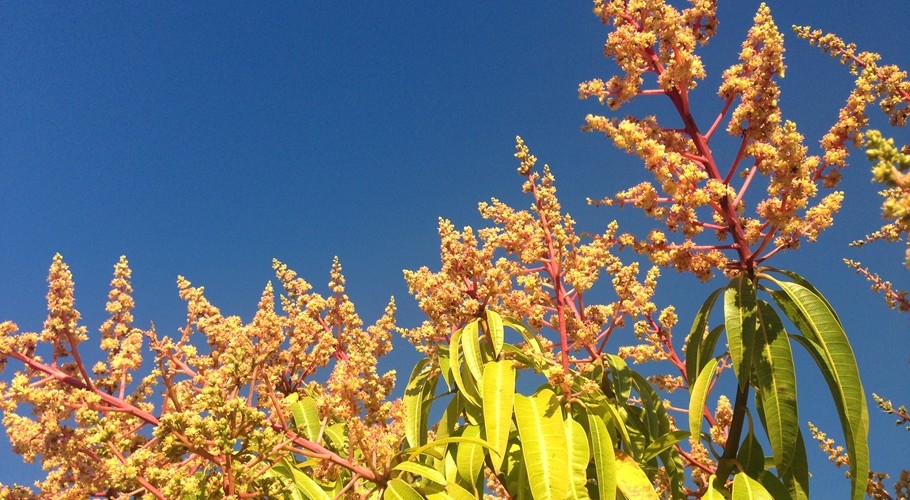It may be Christmas before Honey Gold mango consumers see their favourite fruit in store in any large volume due to conditions affecting this season's Northern Territory supply, according to Piñata Farms Pty Ltd managing director Gavin Scurr.

However Mr Scurr said Honey Gold mangoes produced in other states were on track for a good harvest and fruit quality would be superb.
Honey Gold mangoes are grown exclusively by Piñata Farms and 36 contracted growers in every mainland state except South Australia. Approximately 140,000 trees are under cultivation across 500 hectares.
Mr Scurr, who is also chairman of the Australian Mango Industry Association, said all mango varieties grown in the Northern Territory were affected this season.
"Specifically, the Honey Gold supply out of the Northern Territory will be about 20 per cent of the volume supplied last season," Mr Scurr said.
"This is due to several factors. Honey Gold mangoes need at least 10 consecutive days of minimum temperatures below 15 degrees to achieve good flowering. The region experienced a warmer than usual winter which did not arrive until August and then ended very quickly. This delayed the onset of flowering which usually happens in June and caused the fruit to drop.
"Usually when the fruit gets to golf ball size, the trees naturally drop some, but this year, the fruit got to pea size and dropped."
Piñata Farms has three Northern Territory orchards – two at Katherine and one at Mataranka – with approximately 41,000 trees under cultivation.
Dry weather best for growing mangoes
Mr Scurr said despite a warm winter across northern Australia, conditions for flowering and fruit set had been more positive in other growing regions. Dry conditions were optimum for ensuring quality fruit.
Approximately 350,000-380,000 trays of Honey Gold mangoes will go to market this season.
Traditionally, the Northern Territory's Honey Gold mangoes arrive in store in late November, progressively followed by fruit from Queensland, New South Wales, Victoria and Western Australia throughout the season, until March.
This year's Northern Territory harvest will begin on November 11, with small volumes appearing in supermarkets nationally from November 25.
Mr Scurr said Queensland's northern growing regions would begin harvesting on December 10, with significant volumes appearing on shelves, just in time for Christmas.
"Honey Gold mangoes are hand-picked at mature green stage, packed and transported to ripening rooms in every capital city where it takes up to two weeks to reach 60 to 70 per cent of yellow stage. By the time fruit reaches supermarket shelves, it is 80 per cent yellow and ready for the consumer to buy."
Mr Scurr said the Honey Gold variety was ideal for commercial production as trees produced approximately 15 tonnes per hectare – four times the industry average.
"Trees start producing fruit in their fourth year, reaching full production by year 10," he said.
Piñata Farms was looking to expand Honey Gold plantings in northern and southern states to extend both ends of the season in coming years, he said.
"Not a lot of Australian mangoes are available past March and there is certainly a market for it, so we are investigating that potential."
A relatively new variety which was first commercialised in 2009, Honey Gold mangoes accounted for some eight per cent of the Australian mango market last year.
"We consider any variety earning 10 per cent of the market share and above is a meaningful variety. We are projecting to reach 10 per cent by 2016 when our immature trees reach full production and if other mango producers drop their share as we are expecting."
Honey Gold mangoes were bred by chance in the Rockhampton region in 1991 and are the natural result of a Kensington Pride off-type which was pollinated by another unknown variety.
Piñata Farms bought the plant breeders' rights to the variety in 2002, including the original farm with some 8,000 trees. After the 2011 flood in which 4,000 trees were destroyed, Piñata Farms planted another 3,000 on higher ground.
Mr Scurr said in the past five years, Piñata Farms had invested considerably in Honey Gold research and development to maximise yield and quality.
"We have hand selected growers who employ world's best practices and our supply chain is tightly controlled to ensure consistent quality," he said.
Honey Gold mangoes are fully yellow-orange when ripe, are sweeter than most mangoes and have an intense, punchy flavour. An average of 500-600 grams per piece, they are fibre-free, retain their integrity when cut and have a small seed-high flesh ratio.
"According to consumer research we conducted last season, Honey Gold mangoes are Australia's preferred fresh eating mango. As soon as they arrive in store, people choose them over other mangoes because they look and taste great and are consistent in quality," Mr Scurr said.
Honey Gold mangoes are available nationally at Coles, Woolworths and independent retail outlets under the Piñata brand from November to March.
Honey Gold mango growing regions
- Katherine and Mataranka in the Northern Territory.
- Giru, Bowen, Dimbulah, Mutchilba, Rockhampton, Yarwun, Benaraby, Bundaberg, Wamuran and Gatton in Queensland.
- Byron Bay and Coffs Harbour in New South Wales.
- Robinvale and Mildura in Victoria.
- Kununurra and Carnarvon in Western Australia.
